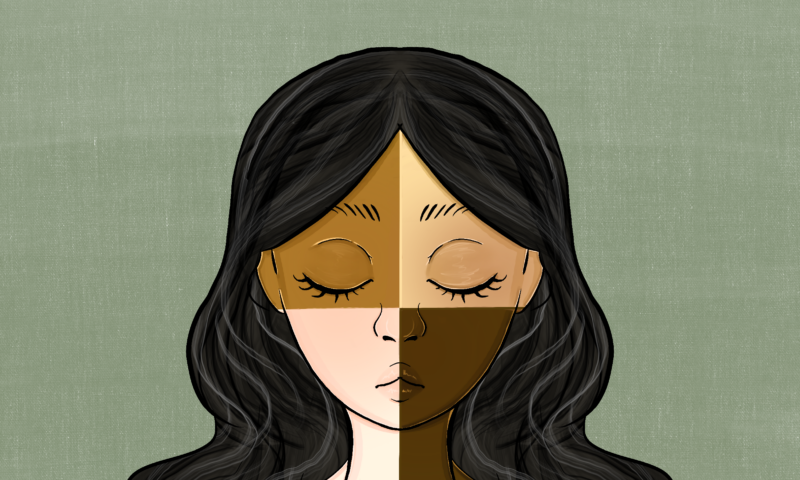Dealing with colorism is more complicated than we think
I grew up in sunny California, where springtime is defined by the sweet scent of blooming flowers and pure, unblemished blue skies, where hardly a day of summer goes by without the sun turning all that the eye can see into a warm, pleasant orange light. I do remember, however, that my childhood days of playing outside were always overseen by a figure who stood in stark, shadowy contrast to the bright lightness and carelessness around her – my mother, who always donned her huge straw sun hat , when we left the house and sought solace in the shade while I played, treating the sun as if even a fleeting touch would threaten her ever-pale skin. I remember wondering even now whether such extreme caution was worth it, whether pallor really was enough to sacrifice the simple, irreplaceable pleasure of sunlight on bare skin.
Of course, at the time, I had little idea of the concept of Colorism, not to mention its ever-present, ongoing influence on a global scale.
Colorism, defined as prejudice against people because of their darker skin color, is an often unrecognized extension of racism. Both are systematic products of ingrained institutions of colonialism and social hierarchy, which continue to influence the aesthetic, ideological, and cultural facets of modern society, although colorism exhibits subtle differences in its historical origin and cultural association within individual ethnic communities. Broadly speaking, the colorism present in African-American communities is most directly related to the European colonial project and slavery, while the colorism for Asian communities can best be understood by first distinguishing between countries included and excluded in European colonialism efforts . In colonized countries like Vietnam or the Philippines, whiteness as a cultural ideal is derived from western communities, which came to value whiteness as a sign of high social status. In East Asian countries without such a direct connection with the western world, colorism can be traced more directly to the gradual association of pale skin with the leisure class, as the manual labor demanded by the working class required more time outdoors and a subsequent darker complexion.
Regardless of its origin, it is important to recognize that the perpetuation of this divide rests on notions that go well beyond white skin, which is merely an indicator of higher social status. Rather, it is also based on the notion that comparatively white skin represents beauty and serenity, while darker skin represents the exact opposite: ugliness, wildness, and inferiority. The implication of this—that members of a minority group have greater worth if they are lighter in complexion—introduces perhaps the most reprehensible aspect of colorism: that it pits people of the same ethnic minority against one another. Although racism can be similarly internalized and practiced within a community, colorism has much more obvious implications for the way members of an ethnic group compete for positions close to whites.
Indeed, the internalization of a white aesthetic ideal is so ingrained that many of us are unaware of the extent to which it is constantly being reinforced. One of the most glaring examples of this can be understood through careful consideration of what we collectively consider to be the physical “default”. Let’s say if a character in a book is of unspecified ethnicity, how do we imagine them until they are more specifically described? Why do we have such a different perception of shows with an all-Black or all-Asian cast versus a show with an all-white cast? The answer lies in the way whiteness has become background in a figure-ground analogy through which people of color are made visible – the first thing that comes to mind when we see a notable aspect of media, that of white Ideal deviates, is mostly an observation about your deviation from the standard setting.
On closer inspection, however, America’s relationship to the white ideal is complicated. While pale skin tends to be judged independently in Asian countries and can be viewed more as a spectrum – with the lightest skin having the highest value and decreasing the further one deviates from this ideal – in America “white” is not defined solely by the complexion of the own skin. Instead, it’s often collectively defined by the presence of Eurocentric traits, meaning that while ‘tan’ has indeed become something of a cultural ideal, it’s not because whiteness has become less valuable. In fact, the idealization of darker skin presupposes the presence of other Eurocentric facial features, which means that darker skin as a positive adjunct to beauty is a privilege reserved only for those who already have a close adherence to the physical definition of whiteness. Even today, the effect of a white ideal goes beyond pure aesthetics; numerous studies show the connection between whiteness and higher economic and social standing.
That being said, how can we begin to combat this phenomenon of modern society, where whiteness has gone from being a cultural ideal to some sort of cultural imperative that offers all sorts of economic and social benefits? In a way, change happens on an individual basis – in other words, by confronting your own inner prejudices and challenging yourself to adopt a mindset separate from cultural norms. It is not enough, however, to acknowledge the vice that the aesthetic and cultural ideal of whiteness inflicts on modern society. In order to really achieve any semblance of systematic change, it is crucial that media representation as a whole changes.
Simply put, feeling beautiful regardless of skin color shouldn’t be a privilege — it should be the norm.


Comments are closed.